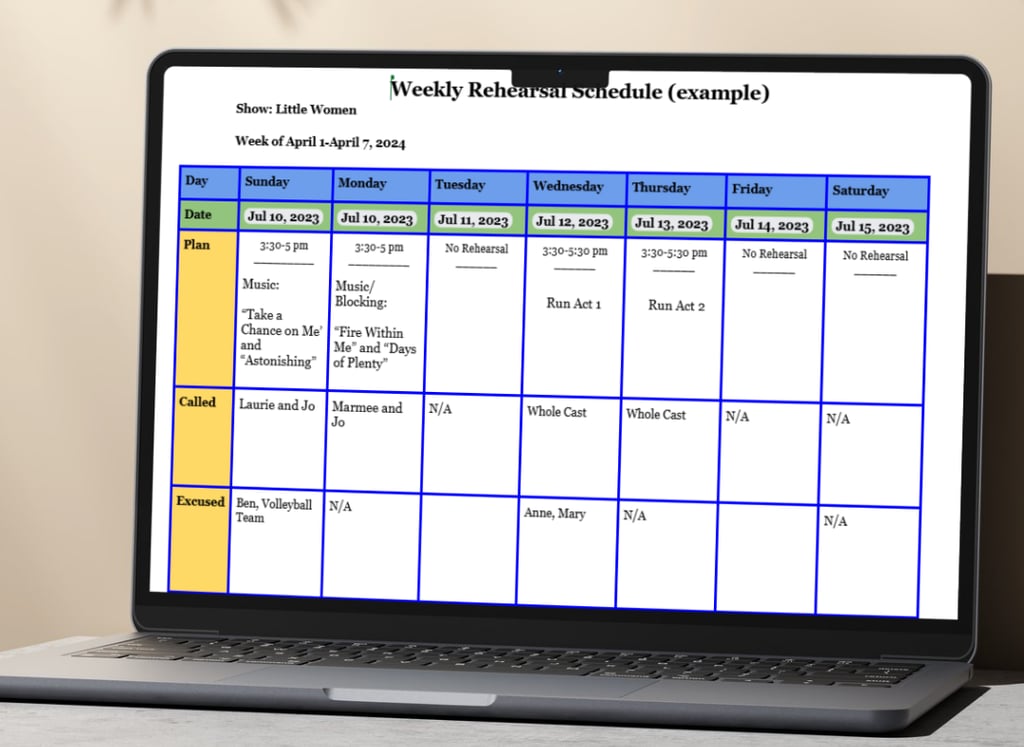How to Create a Rehearsal Schedule for a School Play: A Director's Guide
Learn how to create a rehearsal schedule for a school play with ease. This step-by-step director’s guide covers conflict management, calendar planning, and script breakdown—ideal for busy drama teachers and student-led productions.
Katie Zakkak
7/22/20252 min read


This post is part of my How to Direct a Play series. If you’re looking for a high-level overview for first-time or non-theater teachers, I’ve got a beginner-friendly video linked here. This post, however, is a deeper dive into how to build a rehearsal schedule that works — especially for schools with jam-packed student calendars.
1. Understand the Importance of Scheduling
Scheduling isn’t just about organizing rehearsals. It’s about making your production possible. At the private college-prep school where I teach, my students are involved in everything. That means:
They juggle multiple clubs and AP classes.
They’re resume-building every chance they get.
Scheduling without a system is a disaster waiting to happen.
2. Manage Conflicts Early — During Auditions
📝 Tip: Build the Schedule Around Student Conflicts
Your audition form should include a section where students list their known conflicts. Emphasize clearly:
“Your rehearsal availability helps build the schedule and may affect casting decisions.”
Practical tips:
✅ Let students know that recurring conflicts may affect which roles they’re considered for.
✅ Only honor conflicts submitted at audition time — if it wasn’t listed, it’s not excused.
✅ Students must respect the schedule you build from their information.
3. Build the Rehearsal Calendar
At callbacks, my student stage managers help me fill in a master calendar using a blank schedule template available in my TPT store.
How we do it:
Excused Section: For every date with a known conflict, we list the names of excused students.
Example: If three students are in a club every Tuesday, we put their names on all Tuesdays.
If one student has a doctor appointment, their name goes on that specific date.
This gives me a quick visual guide to casting and rehearsal logistics.
4. Analyze the Script & Block Strategically
Ask yourself:
What scenes or numbers are most time-intensive?
What can be taught in small groups while other parts of the show are rehearsing?
General Flow for Musicals:
Music first (by group or soloist)
Choreography second (group dances, featured solos)
Blocking and table work throughout
Double-dip rehearsals: While one group does music, another does scene work
Key Tip:
Don’t schedule scenes in show order — schedule by practicality. Rehearse what works best for who is actually available on that day.
5. Plan for Run-Throughs and Fix-it Days
Once most of the show is blocked:
Start “Stumble Throughs”: Your first full run, even if it’s messy
Use these to plug missing transitions or group scenes
Leave time for “Fix Rehearsals”: I label these TBD or FIX on the calendar
Communicate clearly:
Ask families to keep TBD dates free
✅ Over-call students if needed — it’s easier to send them home than to add them last-minute
6. Final Tips for Smart Scheduling
Communicate regularly with cast and parents
Use student leaders or stage managers to help track conflicts
Don’t wait to realize you over-scheduled — build in breathing room
Want More Tools?
Grab my Free Drama Teacher Toolkit — it includes:
✅ Goal-setting templates
✅ Free warm-ups
✅ A full production checklist
Also, check out:
My Rehearsal Schedule Template on TPT
And other products to make your life easier!
Happy teaching, happy directing — and break a leg!
[Download the Free Toolkit Here]
